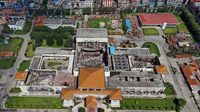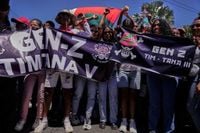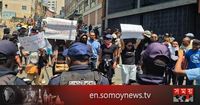In the early days of September 2025, the streets of Kathmandu, Nepal, erupted with a force few could have predicted. What began as a protest against a sweeping social media ban quickly transformed into a nationwide reckoning, fueled by years of frustration over corruption, inequality, and political stagnation. By the time the smoke cleared, at least 19 people were dead, government buildings were in ruins, and Nepal found itself under the leadership of its first-ever female prime minister, Sushila Karki—a retired Supreme Court justice renowned for her anti-corruption rulings.
According to Reuters and Global Voices, the initial spark was the government’s decision to ban social media platforms in September 2025, a move that many saw as an attempt to stifle dissent rather than address the country’s mounting problems. Demonstrators, many of them students, poured into Kathmandu’s streets, holding signs that read, “Stop corruption, not social media.” On September 9, the protests reached a fever pitch as demonstrators gained entry to Nepal’s parliament complex, celebrating what they hoped would be a turning point in their country’s troubled history.
But the cost was steep. As reported by The Good Men Project, police responded to the swelling crowds with tear gas, rubber bullets, and, eventually, live ammunition. Hospitals overflowed with injured students, and the death toll climbed to at least 19. The government, reeling from the violence, imposed a curfew, shut down mobile networks, and deployed the army. That night, the Home Minister resigned, and the cabinet hastily reversed the social media ban. Yet, the protests only spread, with mobs attacking government buildings and the homes of prominent politicians. Former Prime Minister Sher Bahadur Deuba and his wife narrowly escaped harm, rescued by the army after protesters stormed their residence.
Behind the scenes, the movement was coordinated with unprecedented sophistication. As The Kathmandu Post revealed in an in-depth investigation, two Discord servers—Youths Against Corruption and Yuwa Hub—became the nerve centers of the Gen Z uprising. Over just 50 hours, from late September 7 to midnight on September 9, more than 114,000 messages were exchanged on these servers. Plans ranged from peaceful protest logistics to more sinister discussions: making Molotov cocktails, importing arms, and targeting specific government buildings for arson. The platform, originally designed for gamers, had evolved into a digital war room for Nepal’s disaffected youth.
Discord chats analyzed by The Kathmandu Post show the duality of the movement. On September 7, most messages focused on organizing peaceful demonstrations—students planned to attend in school uniforms and document the protests for international media. Yet, as the situation on the ground escalated, so did the rhetoric online. Some users urged restraint, warning against violence and infiltration by groups with vested interests. Others, however, openly called for the use of Molotov cocktails and even discussed importing weapons from India. One user wrote, “If it comes to making Molotovs, don’t target random places—go straight to the parliament building.”
The violence was not limited to the capital. As the government struggled to regain control, attacks spread to the homes of political leaders, including Maoist chairman Pushpa Kamal Dahal and former Prime Minister Deuba. Discord users posted real-time updates as residences were set on fire and crowds gathered outside key sites like the parliament and Baluwatar, the prime minister’s residence. Footage verified by open-source investigators showed protesters throwing petrol bombs, while police confirmed the use of such weapons in the arson attacks.
Amid the chaos, misinformation flourished. Rumors of atrocities, such as a reported rape at a college hostel, spread rapidly on Discord, prompting moderators to intervene and urge users to report falsehoods. Yet the damage was done—panic and anger intensified, and the violence continued to spiral. On September 9, with the parliament and other government buildings ablaze, Prime Minister KP Sharma Oli resigned, though many saw the move as too little, too late.
In the aftermath, President Ram Chandra Poudel appointed Sushila Karki as interim prime minister, a decision that carried symbolic weight. Karki, 73, is a respected figure known for her anti-corruption stance and had the endorsement of the youth representatives who helped lead the protests. In her first statements as caretaker leader, Karki struck a tone of both resolve and empathy. “I will work 18, even 20 hours a day if I must,” she pledged, as reported by Reuters. She also called for calm and institutional change, stating, “Change must come through institutions, not fire,” while acknowledging that young Nepalis were “right to demand dignity and opportunity.”
The roots of the 2025 uprising run deep. Nepal’s modern history is marked by cycles of autocracy, revolution, and disappointment. From the overthrow of the Rana dynasty in 1951, through the Panchayat system and the People’s Movements of 1990 and 2006, each surge of hope has been followed by political paralysis and unmet promises. The new federal democratic republic, established in 2008 after the monarchy’s abolition, brought aspirations for inclusion and reform. Yet, as Global Voices noted, the years that followed saw the same political elites cycling through power, corruption scandals, and widening inequality. By 2024, inflation, youth unemployment, and a sense of stagnation left many Nepalis disillusioned.
Social media, paradoxically both a target and a tool, became the outlet for these frustrations. Hashtags like #NepoKids and #YouthsAgainstCorruption highlighted the privileges of the elite and the anger of those left behind. When the government responded to mounting unrest with further restrictions, the stage was set for confrontation.
International organizations, including Human Rights Watch and Amnesty International, have called for independent investigations into the police and military’s actions during the protests. The military maintains it acted to protect public order, emphasizing that many protesters were minors. Meanwhile, a nine-member committee, led by Superintendent of Police Kaji Kumar Acharya, is investigating the use of chemicals in the arson attacks, with forensic teams collecting samples from the scenes of destruction.
As Nepal looks ahead to new elections scheduled for March 2026, the question remains: will this latest chapter of upheaval mark the beginning of true reform, or will it be another cycle of hope followed by disappointment? For now, the streets of Kathmandu are quiet, but the walls are covered with graffiti demanding change, and students hold nightly vigils in memory of those lost. In the words of one protester, scrawled in bold letters: “If not now, when?”
For Gen Z and many others, the story of 2025 is not a break from the past, but a continuation of Nepal’s long struggle for dignity, opportunity, and accountability. Whether this moment will finally deliver the change so many have sought remains to be seen—but the fire for reform, once lit, is not easily extinguished.






